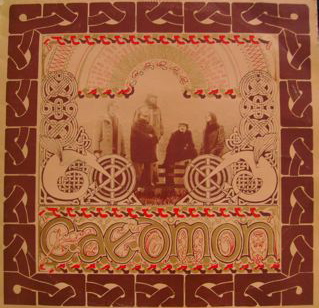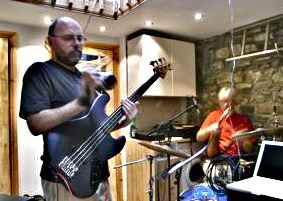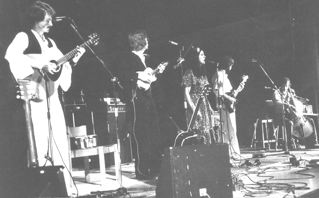And here’s the video evidence
And in case there are any doubters out there, here’s video evidence that Caedmon can actually still play their instruments.
…
The latest news from Caedmon
And in case there are any doubters out there, here’s video evidence that Caedmon can actually still play their instruments.
…
In 1978, a small christian folk rock band in Edinburgh released a farewell album to celebrate six years of making music together. The album was made on a shoestring budget and only 500 copies were pressed. The musicians went their separate ways.

Forty years on, the record remains a collectors item. A new re-release on the Guerssen record label is due and it has been described as one of the best folk rock albums of the seventies.
The band started writing again for the 2008 30th anniversary of the album, and produce ‘A Chicken to Hug’ on CD and on-line.
And with the 40th anniversary they are producing a new package on vinyl called RARE, a 12″ LP and 7″ single in a sleeve with insert: seven new songs, six from 1975 and a surprise track.
So, with all the hype and the misinformation that seems to have followed it, we found ourselves obliged to set the record straight. And what better way than our own web site.
CLICK ON
‘WEBLOG’ for current activity, ‘NOW’ for news of new music making, ‘THEN’ for a historical perspective, and ‘LINKS’ to migrate to other related websites.

Forty two years have passed. The band has got together to record seven new songs in an album called ‘RARE’. These is teamed with six unheard Caedmon tracks from 1975/78 in a vinyl package reminiscent of their first album: a 12″ LP and a 7″ single.
‘RARE’, title track, reflects upon the story of the ’78 album. Originals command four figure prices in the vinyl collecting world and they have become a grail for Acid Folk collectors.
On the 30th anniversary of the break up on the band they reformed meeting for weekends in Weardale, Co. Durham, in the north of England.
Caedmon was always a weird mixture of musicians and their musical influences jostling to find some space to work together. With thirty years to establish and cement those disparate styles, what did this bizarre mixture bring to the table?
Jim doesn’t use a fuzz box to try and rock out quietly, Ken plays everything including the cello, Simon has dropped the bongos for a full drum kit, Sam now plays a gut throbbing five string bass, and Angela… well Angela, initially reluctant, has been persuaded to get behind a mic again. Now she’s a working vet, and possibly the only member of that student band that actually does what she trained for at university.
So how has the music changed in those thirty years? The evidence of their toil is now available on Amazon, iTunes, and eBay in a smart digipak-ed limited edition CD or as download: ‘A Chicken to Hug’
Initial reviews find a connection between the old and new in their music. Also, thankfully, there’s a sense that Caedmon’s music has progressed expressing maturity, variety and novelty.

Find out more about the history of the Acid Folk group Caedmon that started in 1973.
CLICK ON
The album, Other recordings, The band, Classifying Caedmon, The facts,
The gigs, ’73 – ’75, ’75 – ’76, ’76 – ’77
The history, 1973 – 1978, 1979 – 2008
Kissing Spell followed up their rerelease of the Caedmon 1978 album with live tracks from two concerts in 1977 / 1978. London Psalm is everyone’s favourite on blogs.
The tracks are:
1.) London Psalm Sam Wilson, 05 mins 56 secs
2.) Ivory Tower Jim Bisset, 05 mins 16 secs
3.) Worlds and Friends Ken Patterson, 04 mins 47 secs
4.) Aslan Simon Jaquet 05 mins 13 secs
5.) Sea Song Simon Jaquet 05 mins 48 secs
6.) The Garden Caedmon 07 mins 58 secs
7.) Caedmon Hymn Jim Bisset 04 mins 38 secs
8.) Sunchild Jim Bisset 04 mins 41 secs
9.) Heaven Haven Poem: G.M. Hopkins, Music: Simon Jaquet 02 mins 46 secs
10.) Ten Maidens Fair Ken Patterson 04 mins 19 secs
11.) Maker Man Ken Patterson 03 mins 02 secs
12.) Storm Caedmon 06 mins 19 secs 1978
13.) Beyond the Second Mile Sam Wilson 06 mins 48 secs
14.) Columba Jim Bisset 02 mins 42 secs
We recorded a whole bunch of tracks in the Netherbow Arts Centre in 1975?. The Netherbow had a small broadcast studio in the top level, and although it was never really designed for recording bands, it was our first attempt at proper studio recording.
Five of these tracks now appear on RARE.
The farewell concert was also recorded but never published.
Caedmon’s first public concert, Pollock Halls, Edinburgh University.
Andy Love: guitar from Aberdeen
Angela Naylor: vocals from Brighouse, Yorkshire
Ken Patterson: ‘cello, keyboards and guitar from Newcastle upon Tyne
All three were veterinary students.
Simon Jaquet: mandolin, guitar, clarinet and bongoes from Sellindge Kent (a student of French)
Sam Wilson: guitar and bass guitar from Prestwich, Manchester (a student of Chemical Engineering)
Both join the band in early 74. First concert as a 5-piece in Pollock Halls, Baird House common room round about Easter 74. At the end of the summer vacation there is a slightly abortive week’s rehearsal at Elm How, a pink cottage in the Lake District. Andy and Ken can’t make it because of failed resits. Angela, Simon and Sam jam for hours and spend a lot of time walking to the shops which are about 4 miles away. Andy leaves vet school for home in Aberdeen and Ken transfers to Psychology.
Late in 74 Jim Bisset, electric guitar, from Crieff, Perthshire joins the band. He’s studying Divinity.
Simon’s course takes him to France. Fiddler Alan Torrance plays with Caedmon in his absence. Jim, Ken and Sam move into a flat together along with Jim’s sister. They tour widely in a borrowed Austin Maxi and a Volkswagen Caravette. Alan Stevens (another Vet student) helps with sound.
Caedmon appear at the Edinburgh Fringe for a week of late night concerts at The Netherbow Arts Centre on The Royal Mile, with Gordon Strachan (photography), Carolyn Dougill (sound) and George Anderson (lighting).
They start to play weekly in The Mitre pub on the same street. Tony Welbrock starts to sound mix for the band.
Second year at the Edinburgh Fringe for a week of concerts.
At the end of the week they travel overnight in their Ford Transit van ‘Abysilda’ to perform the following afternoon at the Greenbelt Festival in a marquee. Squeezed by programming needs into a meagre slot to accommodate ‘Nutshell’.
They record their eponymous LP to celebrate their five years as a band. They spend two weekends in Barclay Towers Studio in a garret in Bruntsfield. Twelve tracks are mixed down. Ken designs sleeve, Sam the sleeve notes, Angela the lyric sheet and a photo is taken on Arthur’s Seat. Twelve tracks proves to be too much for one album so a 45 rpm single is included in the package. 500 copies are made. They are sold at the Farewell Concert in George Square, Edinburgh in the month of March, to friends and fans. Ken and Angela leave Edinburgh.
Sam and Simon in Cahoots. Jim in Ever After, then on a national tour with Nutshell.
Sam and Simon in The Buskin’ Band. Jim moves to London, then Manchester.
Ken’s work in The Nethrbow Restaurant leads him to buy a Tea Room in Rothbury Northumberland and becomes Egon Ronay Recommended in the ‘Just a Bite Guide’. He assists with the running of Linden Folk with Tony Welbrock, Rod Clements of Lindisfarne and Geoff Heslop of Black Crow records.
Sam and Simon in ‘The Wilde Cigarillos’ and ‘The Fairly Solid Theatre Co.’
Ken sets up ‘Pineapple Agogo’ carnival and dance band with Dodgy Clutch Theatre Co. www.dodgyclutch.com. Albums ‘Big in Winnipeg’ and ‘No Tripe Por Favor’ follow. Jim goes out to Harare, Zimbabwe, teaching English.
Jim returns from Zimbabwe, settles down and gets a real job; discovers computers.
Simon works on a youth project in Botswana and records an album in the Kalahari Desert with Duncan Senyatso and the Kgwape Band playing his own brand of highlife mandolin.
Jim gives up the day job and forms Bernie Hot Hot with David Dunne and Pete Condor.
Ken forms the Heaton People’s Band bringing the first steel pans set to the North East of England. The People soon choose to be called The 10th Avenue Band. www.tenthavenueband.co.uk.
Jim forms Reel Funk Inc with Pete Condor and Shairon Rodgers.
Kissing Spell shows an interest in releasing the 1978 album as a CD.
Simon records ‘Private’ with Dave Heavenor as ‘The Night Visitors’. www.davidheavenor.com.
Kissing Spell releases CD of ‘Caedmon’.
Ken forms The Newcastle All Stars Steel Orchestra an 18 piece teenage band. www.newcastleallstars.org.uk
Simon and Sam form Flaming Nora Ceilidh Band. www.flamingnora.org.uk
Ken coordinates ‘Making Music On the Line’ with Folkworks, Channel 4 and Oxfam. A band of ten musicians from Shetland, Northumberland, Gascony, Catalonia and Burkina Faso perform on a year long project in each of their countries. (Catriona Macdonald, Alison , Sandra Kerr, David Oliver, Pierre Schidt and Les Sous Fifres, Cati Plana, Francina Turon, Salif Ouedrago and Mama Kouyate).
Jim forms the Jazzrascals with Peter Condor, a studio based band who publish their music on the web: www.jazzrascals.com
Ken works with Richard Scott (Grand Union) in Rich Pickings and 4 Corners Music Network. 4cornersmusic.com. The network includes Yousuf Ali Khan, Gerry Hunt, Graham Raine, Cheng Yu and Zed Morgan.
Kissing Spell releases a Caedmon Live CD.
Ken acts with Theatre Sans Frontieres in ‘Le Tour de France’ in a national tour. He starts a relationship with the company composing and music directing. www.tsf.org.uk
Ken composes ‘Tyne Times’ for a Tyneside International Streetband Festival. A massed band of 100 musicians (Germany, France, Netherlands, UK and USA) plays the piece by the Millennium Bridge in Gateshead.
Ken acts in ‘Round the World in 80 Minutes’ a further collaboration with TSF, filmed in Cameroon, Tunisia, Belgium, Switzerland and Quebec for a multi media theatrical show.
Jim sets up the ‘James Bisset: Fiftieth Anniversary Edition’ project.
Ken composes music for TSF’s ‘La Pelota Magica’.
Ken composes music for TSF’s ‘Les Contes Dores”.
Jim, Ken, Sam and Simon meet for 3 days of jamming to develop an album of new material in Weardale, England.
Jim, Ken, Sam and Simon back to Weardale to record over two weekends in October, working up some of the material started in May
Ken and Simon go to Walsall, England, and record Angela’s vocals on four tracks
Jim, Sam and SImon work on the mix in Edinburgh, Scotland.
The band meet in Weardale, jam and decide to record with a producer and released completed demos on this website only
The band meet in Weardale to write / perfect 12 tracks for the future album
The band meet in Weardale to write / perfect 12 tracks for the future album
Whole band rehearses stage set in Weardale Primary School for weekend
Jim, Ken, Sam and Simon record at Durisdeer with Steve Butler
Two nights of Caedmon in concert at The Scottish Story Telling Centre Edinburgh
Angela records vocals for album in Simon’s attic.
Jim, Ken, Sam and Simon record at Durisdeer with Steve Butler, Steve continues to mix over next few weeks.
One day of final mixing with Simon, Ken and Steve.
‘A Chicken to Hug’ is released on iTunes, Amazon, Spotify and as a digipak CD.
2015
Simon and Sam in davesnewbike release ‘wanderlust‘ cd album with Tom Houston and Kris Jozajtis
2016
Friend Peter Ryder challenges Caedmon to write a version of the ‘Dream of the Rood’. They meet up, write and record in Newcastle and Edinburgh and release a demo version on Soundcloud.
2017
Simon and Sam in davesnewbike release ‘The Tin Can and the Flood‘ cd album with Tom Houston and Kris Jozajtis
2019
The whole band meets and makes series of documentary videos with locations around Edinburgh. They work on ‘Runaway’ for the album that is to become ‘RARE’.
They meet a few times to write and record in Edinburgh. Simon and Dave Heavenor look through old 1/4″ tapes from the ’70s and the they are taken to be digitised.
2019
Guerssen Records approach Caedmon for permission to release a vinyl version of the 1978 album (including a 7″ single special INSET and limited edition gold vinyl albums) and Jim remasters from the original 1/4″ master.
2020
New album ‘RARE’ is completed and is released on vinyl and as a CD. Caroline Brown (Simon’s wife) and Sally Jaquet (Simon’s daughter) both contribute with vocals on some of the new tracks.
The 1978 album is available on streaming services for first time as well as the Guerssen rerelease.
2020
Simon and Sam in davesnewbike release ‘Smiling at the Croft’ cd album with Tom Houston and Kris Jozajtis.
2020
Ken creates an animated cartoon version of ‘Sea Song’.
The band meets up and starts on demos four new songs before COVID 19 scupper their plans.